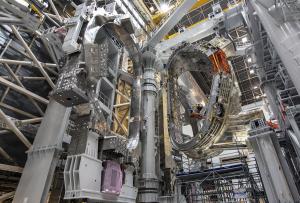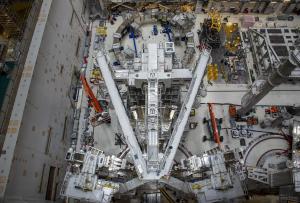First "building block" takes shape
Although it comprises hundreds of thousands of components, a tokamak is essentially a toroidal chamber surrounded by magnetic coils. In ITER, the "chamber," or vacuum vessel, is made of nine 40° sectors, five of which are provided by Europe, the other four by Korea. In the assembly sequence, each sector needs to be associated with two vertical coils, either from Europe or Japan, plus thermal shielding before being lowered and positioned in the assembly pit. This so-called "sub-assembly" is the basic building block of the machine.
In the ITER Assembly Hall, inside one of the tall sector sub-assembly tools (SSAT-2), the first of these building blocks is progressively taking shape. In April, following an eight-month preparatory campaign after it was delivered to ITER, the first vacuum vessel sector from Korea was safely docked, and later equipped with its corresponding thermal shield panels. Panel alignment was confirmed in mid-July.
In June, one of the two vertical coils (TF#12 from Japan) set to be attached to the vacuum vessel sector was extracted from its steel cradle and moved to temporary storage inside SSAT-1. There were several reasons for this stopover: one was the lack of available space in the Assembly Hall and the other the necessity of rehearsing the highly delicate installation of one-of-a-kind component inside a one-of-a-kind tool.
On 10 August, TF#12 was moved into SSAT-2, followed two days later by its twin TF#13, also from Japan. Both coils are now ready for their final embrace of the vacuum vessel sector.
Over the past year, the Assembly Hall has been the stage of many a spectacular operation: components of all sizes, shapes and weight (up to 1,250 tonnes) have been lifted, upended, transported and installed. Some looked like flying saucers, others like a giant Life Savers mint; some were just plain steel, others shone like a silver armband.
What is happening now in the core and wings of the 20-metre-tall sub-assembly tool is no less spectacular but even more alien. Picture three massive components, each as heavy as an Airbus A380 or a fully loaded Boeing 747. The one standing at the centre, smooth on the outside, is pockmarked with dozens of small cylindrical devices like a whale colonized by barnacles. It is the vacuum vessel sector, encased in its silver-plated thermal shield panels.
On both sides of the D-shaped mastodon, the tool's wings stand open, each holding a component of the same general outline, but thinner and sturdier, full of extensions and protruding parts. The twin components' appearance is even stranger than that of the vacuum vessel sector and it takes some knowledge of a tokamak's architecture to identify them—they are the toroidal field coil pair that will be integrated onto vacuum vessel sector #6.
For the moment, nothing is moving except the workers and elevated platforms around the tool. In the coming weeks, when all measurements, alignments and adjustments are done, the tool's wings will begin to move, very slowly, to bring the coils closer and closer to the vessel sector and eventually lock them into place. The process will be a careful and extremely precise one. And although all eyes will be focused on the operation unfolding in the Assembly Hall—the first of nine that must be realized to close the ITER torus—no fewer than 27 construction work packages have to be executed, some deep inside the Tokamak pit, to prepare the way for the installation the first vacuum vessel sector sub-assembly. To this day, 8 of the 27 work packages have been achieved.
In late October, the first 1,200-tonne vacuum vessel sub-assembly of the ITER device will be ready for lift off.
This 4D animation by Brigantium Engineering France for the ITER Organization shows how the 1,200-tonne sub-assembly will be transferred from the sub-assembly tool to its final destination inside the assembly pit.



